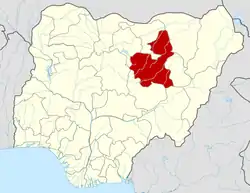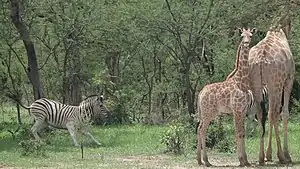Bauchi State
Bauchi State takes its name from the historic town of Bauchi, which also serves as the capital city and is located in the North East of Nigeria. The state was formed in 1976 when the former North-Eastern State was broken up. It originally included the area now in Gombe State, which became a distinct state in 1996.
Bauchi State | |
|---|---|
| Nickname(s): Pearl of Tourism | |
 Location of Bauchi State in Nigeria | |
| Coordinates: 10°30′N 10°00′E | |
| Country | |
| Date created | 3 February 1976 |
| Capital | Bauchi |
| Government | |
| • Governor[1] | Bala Mohammed (PDP) |
| • Deputy Governor | Baba Tela[2] |
| • Senators | [3] |
| • Representatives | List |
| Area | |
| • Total | 49,119 km2 (18,965 sq mi) |
| Area rank | 5th of 36 |
| Population (2006 census) | |
| • Total | 4,676,465 |
| • Rank | 7th of 36 |
| • Density | 95/km2 (250/sq mi) |
| GDP (PPP) | |
| • Year | 2007 |
| • Total | $4.71 billion[4] |
| • Per capita | $983[4] |
| Time zone | UTC+01 (WAT) |
| Postal code | 740001 |
| Dialing Code | +234 |
| ISO 3166 code | NG-BA |
| HDI (2018) | 0.426[5] low · 31st of 37 |
| Website | www.bauchistate.gov.ng |
The Abubakar Tafawa Balewa University is located in the capital city Bauchi. Other educational institutions located in the state include Bauchi State University, Abubakar Tatari Ali Polytechnic[6] and Federal Polytechnic, Bauchi.
Name
According to tradition, it was named for a hunter known as Baushe, who settled in the region before the arrival of Yakubu, the first traditional ruler of Bauchi emirate (founded 1800–10).[7] Bauchi and Adamawa were the two main sources of freedom and tourism for the Fulani empire of Sokoto.[8]
History
What is now known as Bauchi was until 1976 a province in the then North-Eastern State of Nigeria. According to the 2006 census, the state has a population of 4,653,066.
Bauchi State has gone through tremendous transformation over the years. The Ajawa language was spoken in Bauchi State, but became extinct between 1920 and 1940 as speakers switched to Hausa.[9]
During the colonial era up to independence, it formed part of the Bauchi Plateau of the then Northern Region, until the 1967 state creation exercise, when the Bauchi, Borno, and Adamawa provinces constituted the former North-Eastern State.
With the creation of Bauchi State in 1976, then comprising present Bauchi and Gombe State, it included 16 local government areas. The number of local government areas in the then Bauchi State was increased to 20 and later to 23. However, in 1997 when Gombe State was created out of Bauchi and additional local governments were created in the country, Bauchi State was left with 20 local government areas as shown below.
Sharia law was adopted in June 2001.[10]
Local Government Areas
Bauchi State consists of twenty Local Government Areas (LGAs). They are:
_-Yankari_game_reserve%252C_Bauchi_State_(1).jpg.webp)
| LGA | Area (km2) | Census 2006 population |
Administrative capital | Postal code |
|---|---|---|---|---|
| Bauchi | 3,687 | 493,810 | Bauchi | 740 |
| Tafawa Balewa | 2,515 | 219,988 | Bununu | 740 |
| Dass | 535 | 89,943 | Dass | 740 |
| Toro | 6,932 | 350,404 | Toro | 740 |
| Bogoro | 894 | 84,215 | Bogoro | 741 |
| Ningi | 4,625 | 387,192 | Ningi | 742 |
| Warji | 625 | 114,720 | Warji | 742 |
| Ganjuwa | 5,059 | 280,468 | Kafin Madaki | 742 |
| Kirfi | 2,371 | 147,618 | Kirfi | 743 |
| Alkaleri | 5,918 | 329,424 | Alkaleri | 743 |
| Southern region totals | 33,161 | 2,497,782 | ||
| Darazo | 3,015 | 251,597 | Darazo | 750 |
| Misau | 1,226 | 263,487 | Misau | 750 |
| Giade | 668 | 156,969 | Giade | 750 |
| Shira | 1,321 | 234,014 | Yana | 750 |
| Jama'are | 493 | 117,883 | Jama'are | 751 |
| Katagum | 1,436 | 295,970 | Azare | 751 |
| Itas/Gadau | 1,398 | 229,996 | Itas | 751 |
| Zaki | 1,476 | 191,457 | Katagum | 752 |
| Gamawa | 2,925 | 286,388 | Gamawa | 752 |
| Damban | 1,077 | 150,922 | Damban | 752 |
| Northern region totals | 15,035 | 2,178,683 |
Geography
Bauchi State occupies a total land area of 49,119 km2 (18,965 sq mi) representing about 5.3% of Nigeria's total land mass and is located between latitudes 9° 3' and 12° 3' north and longitudes 8° 50' and 11° east.
The state is bordered by seven states, Kano and Jigawa to the north, Taraba and Plateau to the south, Gombe and Yobe to the east and Kaduna to the west.
Bauchi state is one of the states in the northern part of Nigeria that span two distinctive vegetation zones, namely, the Sudan savannah and the Sahel savannah. The Sudan savannah type of vegetation covers the southern part of the state. Here, the vegetation gets richer and richer towards the south, especially along water sources or rivers, but generally the vegetation is less uniform and grasses are shorter than what grows even farther south, that is, in the forest zone of the middle belt.
The Sahel type of savannah, also known as semi-desert vegetation, becomes manifest from the middle of the state as one moves from the state's south to its north. This type of vegetation comprises isolated stands of thorny shrubs.
On the other hand, the southwestern part of the state is mountainous as a result of the continuation of the Jos Plateau, while the northern part is generally sandy.
The vegetation types as described above are conditioned by the climatic factors, which in turn determine the amount of rainfall received in the area. For instance, the rainfall in Bauchi state ranges between 1,300 millimetres (51 in) per annum in the south and only 700 millimetres (28 in) per annum in the extreme north. This pattern is because in the West Africa sub-region, rains generally come from the south as they are carried by the southwesterlies. There is therefore a progressive dryness towards the north, culminating in the desert condition in the far north. So also is the case in Bauchi state.

Consequently, rains start earlier in the southern part of the state, where rain is heaviest and lasts longer. Here the rains start in April with the highest record amount of 1,300 millimetres (51 in) per annum. In contrast, the northern part of the state receives the rains late, usually around June or July, and records the highest amount of 700 millimetres (28 in) per annum.
In the same vein, the weather experienced in the south and the north varies considerably. While it is humidly hot during the early part of the rainy season in the south, the hot, dry and dusty weather lingers up north.
In addition to rainfall, Bauchi state is watered by a number of rivers. They include the Gongola and Jama'are rivers.
The Gongola River crosses Bauchi state in Tafawa Balewa Local Government Area in the south and in Kirfi and Alkaleri Local Government Areas in the eastern part of the state, while the Jama’are River cuts across a number of Local Government Areas in the northern part of the state. Moreover, a substantial part of the Hadeja-Jama'are River basin lies in Bauchi state, which along with various fadama (floodplain) areas in the state provides suitable land for agricultural activities. These are further supported by the number of dams meant for irrigation and other purposes. These include the Gubi and Tilde-Fulani dams. There also lakes such as the Maladumba Lake in Misau Local Government Area that further provide the necessary conditions to support Agriculture.
Population
Bauchi State has a total of 55 tribal groups in which Gerawa, Sayawa, Jarawa, Kirfawa, Turawa Bolewa, Karekare, Kanuri, Fa'awa, Butawa, Warjawa, Zulawa, Boyawa MBadawa, Fulani are the dominant tribe. This means that they have backgrounds, occupational patterns, beliefs and many other things that form part of the existence of the people of the state.
There are cultural similarities in the people's language, occupational practices, festivals, dress and there is a high degree of ethnic interaction especially in marriage and economic existence. Some of the ethnic groups have joking relationships that exist between them, e.g. Fulani and Kanuri, Jarawa and Sayawa, etc.
The Durbar Festival is a major annual attraction.[11]
Languages
West Chadic language groups spoken in Bauchi State:[12]
Languages of Bauchi State listed by LGA:[13]
| LGA | Languages |
|---|---|
| Alkaleri | Fulani,Duguri; |
| Bauchi | fulani,gere. |
| Bogoro | Saya |
| Darazo | Fulani |
| Dass | jerawa Bankal; Dass; |
| Dukku | Fulani |
| Gamawa | Fulani,Karekare |
| Ganjuwa | Fulani ; Miya |
| Kirfi | Fulani, Bure Hausa |
| Misau | Fulani,kanuri |
| Ningi | Fulani, Diri; Gamo-Ningi; Kudu-Camo; Pa'a; Siri; Warji; Geruma |
| Tafawa Balewa | Fulani, Saya |
| Toro | Fulani ; Jere; Panawa; |
| Zaki | Bade Hausa |
Other languages of Bauchi State are Ajawa, Beele, Berom, Kanuri, Kwaami, Manga, Pero, and Piya-Kwonci.[13]
See also
References
- See List of Governors of Bauchi State for a list of prior governors
- "Bauchi State Government (BASG), Nigeria – Official Website". www.bauchistate.gov.ng. Archived from the original on 13 July 2018. Retrieved 13 July 2018.
- https://www.naija.ng/1158185-nigerians-react-senator-ali-wakili-bauchi-dies-58.html&sa=U&ved=0ahUKEwjGg8GkjpzcAhXBAcAKHQSwC5IQFggNMAE&usg=AOvVaw2RHy_X6Td63WNHodoIzhYS//%5B%5D
- "C-GIDD (Canback Global Income Distribution Database)". Canback Dangel. Archived from the original on 16 February 2012. Retrieved 20 August 2008.
- "Sub-national HDI - Area Database - Global Data Lab". hdi.globaldatalab.org. Retrieved 13 September 2018.
- "Bauchi poly secures accreditation for 53 courses". The Nation. 16 January 2018. Retrieved 27 March 2019.
- "Bauchi - state, Nigeria". britannica.com. Archived from the original on 18 October 2014. Retrieved 30 April 2018.
- Johnston, Hugh A.S. (1967). The Fulani Empire of Sokoto. Oxford University Press. p. 161. ISBN 0-19-215428-1.
- Ajawa language at Ethnologue
- "Issue Paper:Nigéria / Protection offerte par l'état". irb-cisr.gc.ca. Research Directorate of the Immigration and Refugee Board of Canada, April 2003. Archived from the original on 20 March 2005. Retrieved 8 July 2008.
- "A 100-Year-Old Muslim Festival of Horse Riding". Folio Nigeria. Retrieved 17 August 2020.
- Blench, Roger (2019). An Atlas of Nigerian Languages (4th ed.). Cambridge: Kay Williamson Educational Foundation.
- "Nigeria". Ethnologue (22 ed.). Retrieved 10 January 2020.